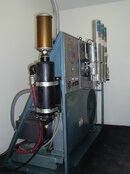You are using an out of date browser. It may not display this or other websites correctly.
You should upgrade or use an alternative browser.
You should upgrade or use an alternative browser.
used compressor?
- Thread starter 3ddiver
- Start date
Please register or login
Welcome to ScubaBoard, the world's largest scuba diving community. Registration is not required to read the forums, but we encourage you to join. Joining has its benefits and enables you to participate in the discussions.
Benefits of registering include
- Ability to post and comment on topics and discussions.
- A Free photo gallery to share your dive photos with the world.
- You can make this box go away
NO DEAL. I shot the guy what we felt was a fair offer and we were not even in the same universe. I finally figured out his magic # was $2000. I am going to pass and keep an eye out for a newer and probably still less expensive unit. Thanks for all of the info.
I'd pay $8-900 for something that old and with its superficial issues. But 2k is not reasonable. New it would be 3.5K or so.
What is everyones big issue with the age, it is still a precision German built machine (keep in mind I have a 1978 Purus just about identical to the one listed that I paid $250 for), Bauer still sells most if not all the parts for the later model Purus, sure the newer Bauer portables have some advantages in higher operating pressure, more CFM's and lighter weight, and an interstage seperator. Filtration may be an issue, but the stock filter is not that much smaller than the P0 system on the current Jr. II and can be changed out for about $450. Otherwise what are you getting for your money when you buy a Jr II, a bit lighter weight (90 vs ~110 pounds (mine is more like 135, but it is in a crash frame, most I have seen for sale are not) may be an issue for some), 3.9 vs 3.4 CFM ( a couple of minutes faster to fill a tank, 22 vs 24 min for a stanard AL 80), max operating pressue 3400 vs 3800psi, (may be an issue for those using HP steel tanks even then is a 50 psi underfill that big of deal, note Bauer did also make a Purus H rated to about 4500 psi), as to the interstage seperator, is it that big of deal?
Ike
Ike
Surface Tension
Contributor
The only issue I would have with age would be air quality. I don't really have any data to back up my opinion, but I would have to imagine the technology has improved somewhat over the last 20 years with the newer units running cooler and by-passing less oil. I'm not really sure if there is any truth to that though, but I'd love to hear someone pontificate on it.
pescador775
Contributor
- Messages
- 2,652
- Reaction score
- 11
All Bauer compressors bypass oil as measured by their high blowby numbers. The newer compressors suck in more oil than the old timers. This is due to the fact that after 1975 Bauer installed PCV tubes and all blowby is thereby pumped directly into the first stage for recycling. Air quality is a function of heat, intake air content and filter size and quality. The subject of air quality is way overblown by a nervous public and this fact is noted by manufacturers who wish to avoid litigation. The primary purpose of the filtration system is to prevent harm to the SCUBA tank which, if degraded by rust, could be quite hazardous to any number of people including the diver. If that is taken care of, then, generally, the air is safe to breath although it may have a bad odor, typically an oil taste. However, higher quality compressor oils are not poisonous, although in very large concentrations like 5000 mg/m3 could cause a gag reflex, and over time, could lead to oil pneumonia. That number is about 1000 X the amount produced by old portables and the like. Older compressors used a small canister of activated charcoal to remove taste and odor. These arrangements are plenty safe to breath at any depth. However, in the context of a wealthier and more cautious society, and to improve competitive positions, it is now customary to to sock in several filter media removing any but trace contaminants detectable only with special apparatus.
Pontificus
Pontificus
captain
Contributor
Older compressors used a small canister of activated charcoal to remove taste and odor. These arrangements are plenty safe to breath at any depth. Pontificus
My 1967 U S Divers Luchard compressor came with only activated charcoal filtration. It is only within the last 5 years that I added a seive tower to it. More to bring it up to modern standards than for air quality reasons.
What is everyones big issue with the age, it is still a precision German built machine (keep in mind I have a 1978 Purus just about identical to the one listed that I paid $250 for),
There's nothing "wrong" with it. Based on new prices nowadays, I'd pay $800 ish for something that old and of mystery heritage. Parts probably are available, but if you've seen Bauer's prices you'll factor some new ones (eg. 3rd stage valves or a really gunky intercooler that needs replacing) into the purchase price. That knocks some value off IMO.
Similar threads
- Replies
- 8
- Views
- 423
- Replies
- 0
- Views
- 515
- Replies
- 5
- Views
- 342
- Replies
- 24
- Views
- 2,242
- Replies
- 14
- Views
- 1,113






